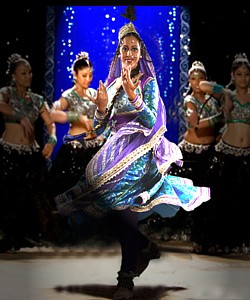

Kathak and Classical Indian Dancers
Our solo dancer and dance troupe perform to classic, timeless songs with a fiery energy, adhering to the techniques of Indian classical dance. They have been captivating audiences since 2005, with their powerful performances. Each of the dance pieces have been choreographed by our solo dancer herself, with the greatest detail and sensitivity, entertaining guests with an authentic yet timeless cultural experience of beauty and magic. The music accompanied to the dance ranges from soft and mellow to fast and furious. Enhancing one’s audio as well as visual experience. The costumes are lavish, with rich fabrics and hand embroidered work.
The performance explores various emotions and moods, so the audience too go on a journey with our solo dancer and her dance troupe.
She leads them, goes with them and follows them through various aspects of the dance.
This is not just entertainment, this is art. A form of art which cannot be described, but only experienced.
Their current client base includes HSBC, Vodafone, Ford and many other reputable companies who choose only the classiest entertainment for their high profile events.
Solo Dancer and Troupe Options
Solo Dancer includes:
Our solo dancer’s passion for Indian culture is clearly demonstrated by her soulful performances. For a young artist, her unique quality is to take her audiences on a journey, focusing on the holistic aspects of classical dance. Her dances can be devotional, technical and expressive. She can be booked as the lead dancer of the Indian dance troupe and also performs solo.
Price from £450.00
Classical Indian Kathak Dance
Kathak is not just a dance form, it is an art and is one of the oldest forms of art in the World. Being one of the seven Classical Indian dances of India, Kathak dance originates from Northern India and has a history since 1550BC, older then any other dance form of today. Classical Indian – Kathak Dance first started as a devotional art form in the Hindu temples of North India in the 15th centaury. It was born as a simple, spiritual form of pure dance which was only danced by priests in front of Gods and devotees.
Over hundreds of years the dance forms evolved and were merged into today’s Kathak Dance which is still the only form of dance in the world that is a merge of two cultures although still a very well respected, spiritual and disciplined form of art.
During the Mughal rule of India, Mughal Kings ordered for Persian and Indian Dancers to perform in their courts. The Persian Dance and culture was merged with the Indian arts to build the repertoire and adapt it into a more entertaining form. From here Kathak dance became adapted and Mujra dance started, which became very popular in Bollywood films, hence the misconception of Kathak as Mujra Dance.
The dance form also went through a period through the Rajistani palaces, where the Hindu mythological stories was recollected. Poems and short stories were composed, particularly about Radha and Krishna, which are still danced to today. During the British rule, Kathak was banned for some time before being eventually put on stage in auditoriums and theatres.
Over great lengths of time, the dance form has evolved incredibly, from temples to stages but has still maintained the traditional influences of both the Hindu and Mughal styles. Today there are three
Great masters and Gurus have played a core role in developing the art form’s wide and complex repertoire, and have uniformed Kathak globally.
Today Kathak is one of seven Classical dance forms in India, and audiences get mesmerised by the technical elements including the fast yet precise footwork patterns, the fluid hand movements, the table-top spins and the intricate compositions that are recited and then danced to the beats of the tabla. Not to mention the expressional, storytelling aspect of Kathak dance, where the dancer depicts a story through expression and characterisation.
For a Kathak student to thoroughly learn the form is a life changing experience. In order to justify its technical requirements, expressions, understanding of the rhythmical system etc, they must devote time and sincerity to it. The traditional method of learning which still exits today is known as the Guru Sheeshya Parampara. This is a disciplined and structured way of learning the art form in depth through faith in the Guru (teacher) and their knowledge. There is also the Western method of studying according to a syllabus and taking examinations in Kathak available leading to qualifications.
However, if a student is able to go into depth into the form, they can experience a soulful journey which can be continued throughout their lives.